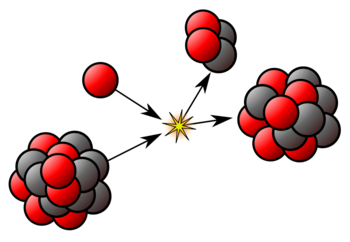Nuclear binding energy
Nuclear binding energy is the minimum energy that would be required to disassemble the nucleus of an atom into its component parts. These component parts are...

The process of dating an ancient object by measuring the proportion of 6C12 to its radioisotope 6C14 . in a specimen is known as carbon dating.
The atmosphere contains carbon 6C12 and its radioisotope 6C14. Neutron by cosmic rays reacts with nitrogen in the air to form 6C14 as below:
7N14 + 0n1---------------------------------- 6C14 + 1H1
The ratio of 6C14 to 6C12 in the atmosphere is about 10-12. Both 6C12 and 6C14 combine with oxygen to from carbon dioxide that is absorbed by the living plants during photosynthesis process. But 6C14 is a beta emitter and decays back into nitrogen as
6C14 --------------------------------- 7N14 + -1e0
Hence, the amount of 6C14 goes on decaying. As the living plant performs photosynthesis, the deacy of 6C14 is compensated by a new supply of it from atmospheric air and a radioactive equilibrium is reached where there is a fixed ratio of 6C14 to 6C12
When the plant dies, no more 6C14is taken in and that inside the plant begins to decay at a known rate without any replacements. 6C14 has half life of 5730 years. By determining the carbon content of a sample and measuring its activity, we can determine when the organism died or the life of that object.
Suppose the activity of some dead material was R0 at the time of death and it has been reduced to R after t years. Then, according to law of radioactive decay, we have

But where T= 5730 years, the half-life of the radioactive carbon. SO,
where T= 5730 years, the half-life of the radioactive carbon. SO,

Hence by measuring the activity R0 of the living plant and activity R of its dead material, the age t of that object can be determined.